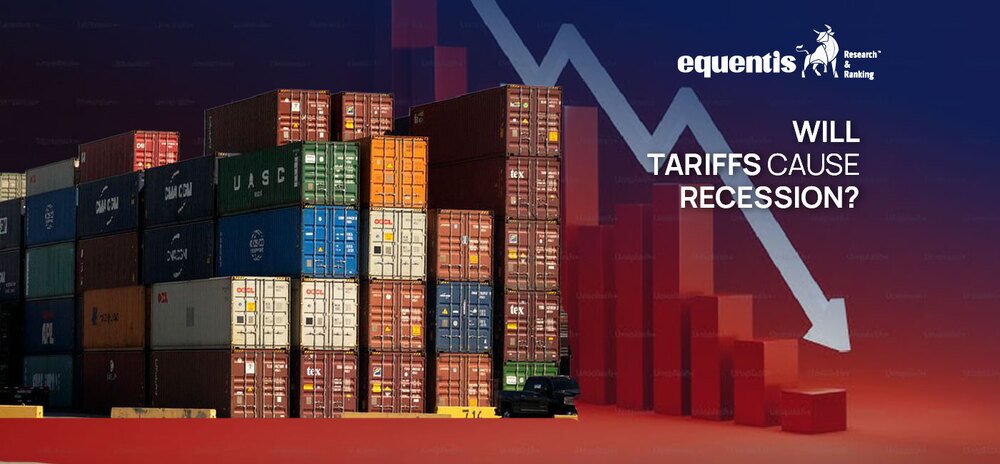When Donald Trump floated the idea of a 10% universal import tariff—and as much as 60% on Chinese goods—it wasn’t just a campaign headline. It reopened a long-standing debate: can aggressive protectionism trigger the next global recession?
With inflation still sticky, monetary policy stretched, and geopolitical tensions high, this is more than a U.S. election-year stunt. It’s a policy shift with global consequences. To unpack whether tariffs will push economies into recession, we must understand the transmission mechanisms—from price levels and investment behavior to currency shocks and global demand.
Tariffs: A Tax with Long Tails
Tariffs are often portrayed as a tool to protect domestic industry. But economically, they are regressive taxes. They raise the cost of imported goods, which then filters into:
- Consumer prices (higher inflation)
- Corporate margins (especially for firms relying on global supply chains)
- Investment behavior (uncertainty discourages capex)
- Exports (due to retaliation)
According to the Tax Foundation, a 10% universal tariff would mean a $300 billion tax increase for U.S. consumers over 10 years. That’s more than the annual GDP of countries like Portugal or New Zealand.
Moreover, as per the Federal Reserve Bank of New York, tariffs during the 2018–2019 U.S.-China trade war raised input costs for manufacturers by 8%, contributing to a significant slowdown in factory orders and capital expenditure.
Could It Tip the U.S. Into Recession?
A U.S. recession isn’t a theoretical possibility—it’s a statistical probability if tariffs rise drastically in an already fragile macro environment.
Here’s how the dominoes may fall:
- Higher Prices = Delayed Rate Cuts
According to Oxford Economics, a 10% import tariff is expected to add 1.8 to 2 percentage points to inflation. This may force the Federal Reserve to hold interest rates above 5% well into 2026, suppressing consumption and borrowing. - Demand Shock + Investment Freeze
With higher prices and interest rates, household spending and corporate investment would decline. As of Q1 2025, actual personal consumption is already slowing, growing at just 1.2% YoY, down from 2.7% a year ago. - Trade Retaliation and Global Rebalancing
The EU and China have already hinted at reciprocal tariffs. This reduces demand for U.S. exports, leading to a drop in production, especially in industrial and agri-export hubs like the Midwest. - Unemployment Creeps Up
Manufacturing job growth in the U.S. is already stalling—March 2025 added only 5,000 manufacturing jobs, down from a monthly average of 18,000 in 2023. With rising input costs, job cuts may follow.
The U.S. economy is walking a tightrope, and broad tariffs could tip the balance.
The Global Fallout: Who’s Most Vulnerable?
1. China
Trump’s proposed 60% tariff on Chinese goods would further destabilize China’s export sector, which already saw a 6.5% YoY drop in shipments to the U.S. in 2024. The shock would weaken the yuan, trigger capital flight, and potentially force Beijing to boost fiscal stimulus.
- Export-to-GDP Ratio (China): 21% (Statista)
- % of Exports to the U.S.: ~17%
2. Germany & the EU
Germany, Europe’s manufacturing engine, exports nearly 50% of its GDP. If global demand weakens, the eurozone may slide into recession again following 2023’s near-zero growth. Sectors like autos and machinery would be hit hard.
- Germany’s Exports to the U.S.: ~$157 billion (2024)
- Dependency on global demand: Extremely high due to low domestic consumption.
3. Southeast Asia & Mexico
Vietnam, Taiwan, and Mexico are key parts of global supply chains. For instance, Vietnam sends 28% of its total exports to the U.S. A slowdown in U.S. demand would ripple into factory closures and currency volatility.
Source: Statista, World Bank, WTO Trade Data
4. Commodity Exporters
Tariff-driven demand slowdown in industrial nations would also reduce demand for commodities. Countries like Brazil (soybeans), Australia (iron ore), and South Africa (metals) may face lower prices and revenue shortfalls.
Is This 2018 All Over Again?
In many ways, no. The macro backdrop today is more fragile. Global interest rates were near zero during the 2018-2019 trade war. Central banks had room to cut. Today, most are already in tightening or neutral mode. It limits monetary flexibility to cushion the blow.
Also, corporate balance sheets are more fragile, especially in China and Europe. Global corporate debt as a percentage of GDP rose 102% in 2024, up from 89% in 2019.
Is India Vulnerable to a Global Recession?
Yes, but with caveats.
India is not immune to a global recession but is better insulated than many other emerging markets.
Here’s why:
Factors That Shield India
- Domestic Demand-Driven Economy
Unlike export-heavy nations (like Vietnam or Germany), India’s GDP is driven ~60% by domestic consumption, which acts as a buffer. - Services Resilience
India’s IT and business services sector (~8% of GDP) remains globally competitive and essential, even in downturns. Many global firms outsource more during recessions to cut costs, which benefits India. - Healthy Forex Reserves
As of March 2025, India has $640 billion in forex reserves, giving it room to manage currency volatility and imports. - Macroeconomic Management
Inflation, while sticky, has been moderating. The RBI has built credibility in balancing growth and inflation, and fiscal policy is relatively conservative compared to peers.
Risks and Vulnerabilities
- Export Exposure to the U.S. & EU
While exports are only ~20% of India’s GDP, the U.S. and EU account for 30% of India’s total exports. A slowdown there would hit sectors like textiles, engineering goods, and software services. - Oil Prices and Capital Flows
In a global slowdown, oil prices might initially fall, but if geopolitical tensions rise (say, in the Middle East), prices may spike, hurting India’s import bill. Also, FII outflows often increase during global stress. - Unemployment & Informal Sector Stress
A global slowdown can impact job creation, especially in export-oriented SMEs and gig economy sectors. This could widen income inequality.
Economic Consequences of a Global Recession
A full-blown global recession can create first-order and second-order effects:
| Consequences | Impact |
| Demand Contraction | Reduced sales for exports, lower revenues |
| Investment Freeze | Delay in FDI, private sector capex cuts |
| Employment Stress | Job losses in trade-exposed and IT sectors |
| Fiscal Strain | Government spending may rise to support jobs |
| Credit Risks | Defaults may rise in MSME and retail loans |
| Currency Volatility | INR depreciation due to capital outflows |
Is There a Silver Lining to a Recession?
Yes. Recessions, while painful, can reset imbalances and offer structural opportunities. Here’s how:
1. India as an Alternative to China
Global firms seeking “China Plus One” diversification may accelerate supply chain moves to India, especially in electronics, pharmaceuticals, and renewable energy. For instance:
- Apple now assembles 12–14% of its iPhones in India (Source: Bloomberg, 2025).
- India’s PLI (Production Linked Incentive) schemes could attract more investment during shifts.
2. Lower Global Commodity Prices
A global recession typically reduces demand for oil, metals, and agri-products. For India, which imports over 80% of its crude, this means lower inflation and improved trade balance—freeing up space for fiscal support or rate cuts.
3. Tech & Talent Outsourcing Boom
As global companies cut costs, India’s tech services may see a surge in demand. During the 2008 recession, Indian IT firms like TCS and Infosys grew faster than the global average.
4. Policy Reforms Under Pressure
Recessions often force governments to act boldly. India may push forward:
- Labor market reforms
- Infrastructure investment
- Trade diversification
- Easing compliance for MSMEs
What Can Be Done to Avoid a Recession?
- Targeted Tariffs, Not Blanket Measures
Instead of a universal tariff, a nuanced approach focusing on strategic goods (e.g., EVs, semiconductors) could protect domestic interests without stoking a global shock. - Supply Chain Diversification
For businesses, shifting procurement to India, Indonesia, or Latin America could help reduce dependence on tariff-prone geographies. The “China Plus One” strategy is gaining ground. - International Trade Coordination
Platforms like the WTO, G7, and APEC must play a bigger role in mediating disputes. The world can’t afford another full-blown trade war. - Fiscal Policy Readiness
Governments must keep fiscal stimulus tools ready—especially in export-reliant nations. Support to vulnerable sectors and households could soften the landing.
Tariffs, Recession, and Risk Multipliers
Trade policy is not made in a vacuum. In 2025, the world is still absorbing the aftershocks of a pandemic, a war in Eastern Europe, and tight monetary policy. Trump’s tariff ambitions may offer political dividends—but economically, they risk pushing the U.S. and the world toward a recession.
If protectionist policies gain traction without complementary buffers—such as diplomacy, diversification, and smart monetary coordination—the odds of a global downturn increase sharply.
Related Posts
Disclaimer Note: The securities quoted, if any, are for illustration only and are not recommendatory. This article is for education purposes only and shall not be considered as a recommendation or investment advice by Equentis – Research & Ranking. We will not be liable for any losses that may occur. Investments in the securities market are subject to market risks. Read all the related documents carefully before investing. Registration granted by SEBI, membership of BASL & the certification from NISM in no way guarantee the performance of the intermediary or provide any assurance of returns to investors.
How useful was this post?
Click on a star to rate it!
Average rating 0 / 5. Vote count: 0
No votes so far! Be the first to rate this post.
waitfor delay '0:0:5'--
I’m Archana R. Chettiar, an experienced content creator with
an affinity for writing on personal finance and other financial content. I
love to write on equity investing, retirement, managing money, and more.
 Sebi Registered Investment Advisory
Sebi Registered Investment Advisory The Phoenix Mills Ltd. (PDF)
The Phoenix Mills Ltd. (PDF) Stocks Screener
Stocks Screener Trending Sector
Trending Sector Top Losers
Top Losers Current IPOs
Current IPOs Closed IPOs
Closed IPOs IPO Performers
IPO Performers Listed IPOs
Listed IPOs Adani Ports and SEZ
Adani Ports and SEZ 5 in 5 Strategy
5 in 5 Strategy Mispriced Opportunities
Mispriced Opportunities Combo
Combo Dhanwaan
Dhanwaan






















